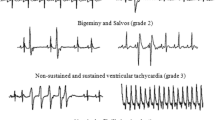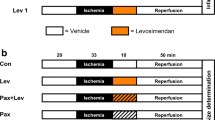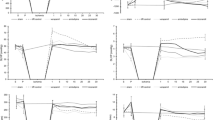Abstract
To study the protective effect of mitochondrial ATP-sensitive K+ channel (mitoKATP channel) opener, nicorandil, combined with Na+/Ca2+ exchange blocker KB-R7943 on myocardial ischemia–reperfusion injury in isolated rat hearts; the isolated rat heart was perfused by modified Langendorff device, after 15-min balanced perfusion, 45-min ischemia (about left and right coronary perfusion flow reduced to 5% of the original irrigation flow), and 2-h reperfusion were performed. Forty Wistar rats were randomly divided into four groups: control group, nicorandil group, KB-R7943 group, and the combination of nicorandil and KB-R7943 group. After 45-min ischemia and then 2-h reperfusion, the myocardial infarct size was 34.31% in control group, 26.35% in nicorandil group, 28.74% in KB-R7943 group, and 19.23% in combination of nicorandil and KB-R7943 group. SOD activity in coronary perfusion fluid was the highest in the combination of nicorandil and KB-R7943 group, and MDA content was the lowest. In the combination drug group compared with the control group, myocardial ultrastructural injury was significantly reduced. The combination of nicorandil and KB-R7943 significantly reduced myocardial infarct size, significantly reduced myocardial ultrastructural damage, could increase coronary perfusion fluid SOD activity, and reduced MDA levels.

Similar content being viewed by others
References
Fujita, A., & Kurachi, Y. (2000). Molecular aspects of ATP-sensitive K+ channels in the cardiovascular system and K+ channel openers. Pharmacology and Therapeutics, 85, 39–53.
Gross, G. J., & Auchampach, J. A. (1992). Blockade of ATP-sensitive potassium channels prevents myocardial preconditioning in dogs. Circulation Research, 70(2), 223.
Rajesh, K. G., Sasaguri, S., Suzuki, R., et al. (2004). Ischemic preconditioning prevents reperfusion heart injury in cardiac hypertrophy by activation of mitochondrial KATP channels. International Journal of Cardiology, 96(1), 41.
Garlid, K. D., Pauce, K. P., Yarov-Yarovoy, V., et al. (1996). The mitochondrial K+ channel as a receptor for potassium channel openers. Journal of Biological Chemistry, 271, 8796–8799.
Nakai, Y., Horimoto, H., & Mieno, S. (2001). Mitochondrial ATP-sensitive potassium channel plays a dominant role in ischemic preconditioning of rabbit heart. European Surgical Research, 33, 57–63.
Philipson, K. D., Nicoll, D. A., Ottolia, M., et al. (2002). The Na+/Ca2+ exchange molecule: An overview. Annals of the New York Academy of Sciences, 976, 1–10.
Bers, D. M., Barry, W. H., & Despa, S. (2003). Intra cellular Na+ regulation in cardiac myocytes. Cardiovascular Research, 57, 897–912.
Fujioka, Y., Hiroe, K., & Matsuoka, S. (2000). Regulation kinetics of Na+/Ca2+ exchange current in guinea-pig ventricular myocytes. Journal of Physiology, 529, 611–623.
Lee, C., Dhalla, N. S., Hryshko, L. V., et al. (2005). Therapeutic potential of novel Na+/Ca2+ exchange inhibitors in attenuating ischemia-reperfusion injury. Canadian Journal of Cardiology, 21, 509–516.
Iwamoto, T., Kita, S., & Shigekawa, M. (2002). Functional analysis of Na+/Ca2+ exchanger using novel drugs and genetically engineered mice. Folia Pharmacologica Japonica (Nippon Yakurigaku Zasshi), 120(1), 91P–93P.
Iwamoto, T., Kita, S., Uehara, A., et al. (2001). Structural domains influencing sensitivity to isothiourea derivative inhibitor KB-R7943 in cardiac Na+ /Ca2+ exchanger. Molecular Pharmacology, 59, 524–531.
Elias, C., Lukas, A., Shurraw, S., et al. (2001). Inhibition of Na+/Ca2+ exchange by KB-R7943: Transport mode selectivity and antiarrhythmic consequences. American Journal of Physiology, 281, H1334–H1345.
Ladilov, Y., Haffner, S., Balser-Schafer, C., et al. (1999). Cardioprotective effects of KB-R7943: A novel inhibitor of the reverse mode of Na+/Ca2+ exchanger. American Journal of Physiology, 276, 1868–1876.
Schafer, C., Ladilov, Y., Inserte, J., et al. (2001). Role of the reverse mode of the Na+/Ca2+ exchanger in reoxygenation-induced cardiomyocyte injury. Cardiovascular Research, 51, 241–250.
Inserte, J., Garcia-Dorado, D., Ruiz-Meana, et al. (2002). Effect of inhibition of Na+/Ca2+ exchanger at the time of myocardial reperfusion on hypercontracture and cell death. Cardiovascular Research, 55, 739–748.
Magee, W. P., Deshmukh, G., Deninno, M. P., et al. (2003). Differing cardioprotective efficacy of the Na+/Ca2+ exchanger inhibitors SEA0400 and KB-R7943. American Journal of Physiology, 284, H903–H910.
Matsumoto, T., Miura, T., Miki, T., et al. (2002). Blockade of the Na+/Ca2+ exchanger is more efficient than blockade of the Na+–H+ exchanger for protection of the myocardium from lethal reperfusion injury. Cardiovascular Drugs and Therapy, 16, 295–301.
Tsuchida, A., Miura, T., Tanno, M., et al. (2002). Infarct size limitation by nicorandil: Roles of mitochondrial K(ATP) channels, sarcolemmal K(ATP) channels, and protein kinase C. Journal of the American College of Cardiology, 40(8), 1523–1530.
Jia, D., Zheng, X.-W., Qi, G. X., et al. (2000). The influence of KATP channel opener JTV-506 on areas of isolated myocardial infarction in rat. Acta Pharmaceutica Sinica, 35(10), 743–746.
Taira, N. (1987). Similarity and dissimilarity in the mode and mechanism of action between nicorandil and classical nitrates: An overview. Journal of Cardiovascular Pharmacology, 10, S1–S9.
Taira, N. (1989). Nicorandil as a hybrid between nitrates and potassium channel activators. American Journal of Cardiology, 63, 18J–24J.
Krumenacker, M., & Roland, E. (1992). Clinical profile of a nicorandil: An overview of its hemodynamic properties and therapeutic efficacy. Journal of Cardiovascular Pharmacology, 20, S93–S102.
Imagawa, J., Baxter, G. F., & Yellon, D. M. (1998). Myocardial Protection afforded by nicorandil and ischemic preconditioning in a rabbit infarct model invivo. Journal of Cardiovascular Pharmacology, 31, 74–79.
Mizumura, T., Nithipatikom, K., & Gross, G. J. (1995). Effects of nicorandil and glyceryl trinitrate on infarct size, adenosine release, and neutrophil infiltration in the dog. Cardiovascular Research, 29, 482–489.
Patel, D. J., Purcell, H. J., & Fox, K. M. (1999). Cardioprotection by opening of the KATP channel in unstable angina: Is this a clinical manifestation of myocardial preconditioning? Results of a randomized study with nicorandil. CESAR 2 investigation. Clinical European Studies in Angina and Revascularization. European Heart Journal, 20, 51–57.
Maxwell, S. R., & Lip, G. Y. (1997). Reperfusion injury: A review of the pathophysiology, clinical manifestations and therapeutic options. International Journal of Cardiology, 58, 95–117.
Gross, G. J., Pieper, G., Farber, N. E., et al. (1989). Effects of nicorandil on coronary circulation and myocardial ischemia. American Journal of Cardiology, 63, 11J–17J.
Lazdunski, M., Frelin, C., & Vigne, P. (1985). The sodium/hydrogen exchange system in cardiac cells; its biochemical and pharmacological properties and its role in regulating internal concentrations of sodium and internal pH. Journal of Molecular and Cellular Cardiology, 17, 1029–1042.
Griffiths, E., & Halestrap, A. P. (1993). Protection by cyclosporine A of ischemia/reperfusion-induced damage in isolated rat hearts. Journal of Molecular and Cellular Cardiology, 25, 1461–1469.
Nakamura, A., Harada, K., Sugimoto, H., et al. (1998). Effects of KB-R7943, a novel Na+/Ca2+ inhibitor, on myocardial ischemia/reperfusion injury. Folia Pharmacologica Japonica (Nippon Yakurigaku Zasshi), 111, 105–115. (Abstr. in English).
Elmali, N., Esenkaya, I., & Karadag, N. (2007). Effects of resveratrol on skeletal muscle in ischemic-reperfusion injury. Ulusal Travma ve Acil Cerrahi Dergisi, 13, 274–280.
Author information
Authors and Affiliations
Corresponding author
Rights and permissions
About this article
Cite this article
Jia, D. The Protective Effect of Mitochondrial ATP-Sensitive K+ Channel Opener, Nicorandil, Combined With Na+/Ca2+ Exchange Blocker KB-R7943 on Myocardial Ischemia–Reperfusion Injury in Rat. Cell Biochem Biophys 60, 219–224 (2011). https://doi.org/10.1007/s12013-010-9142-8
Published:
Issue Date:
DOI: https://doi.org/10.1007/s12013-010-9142-8




